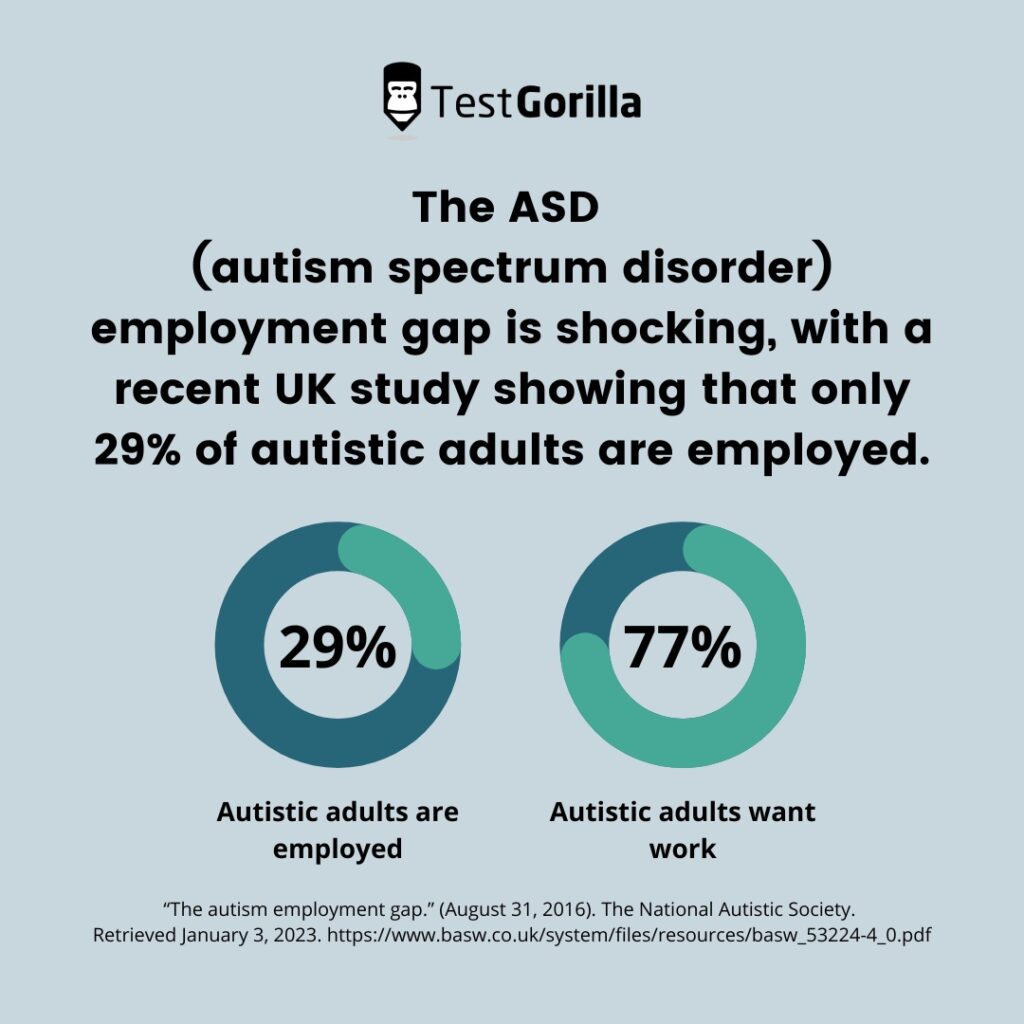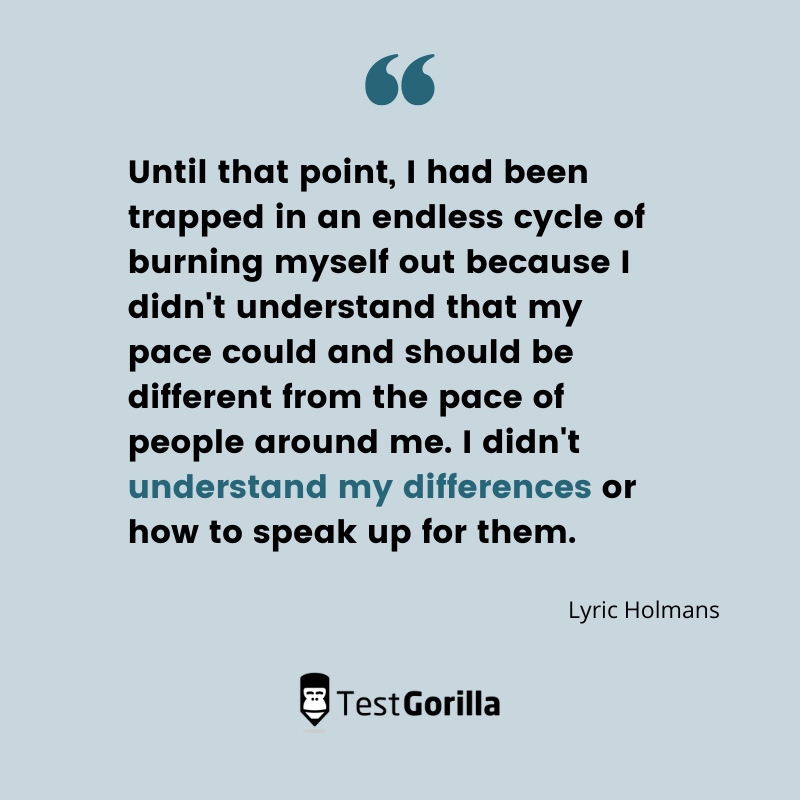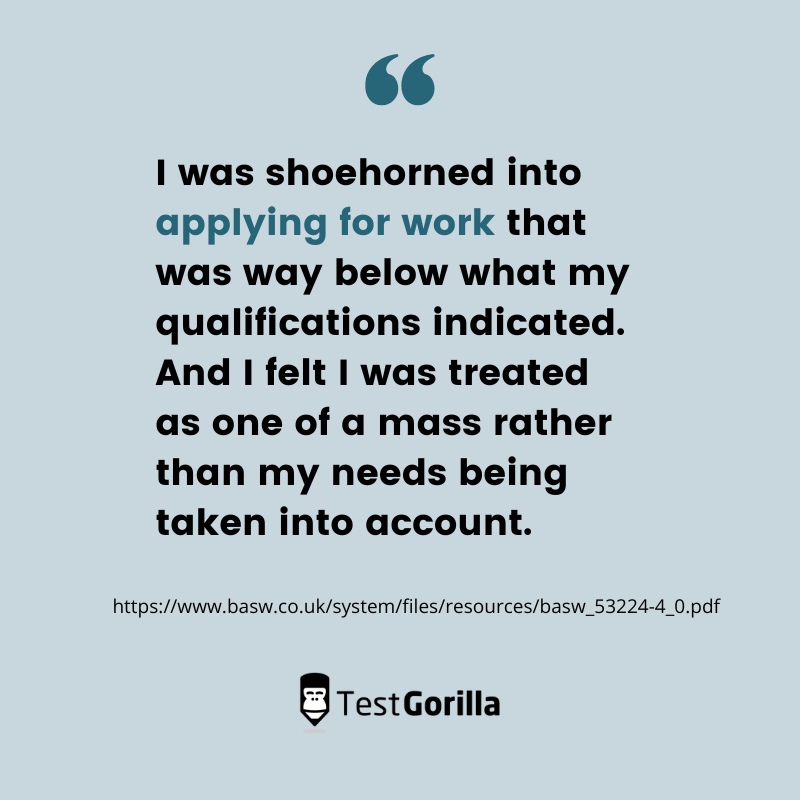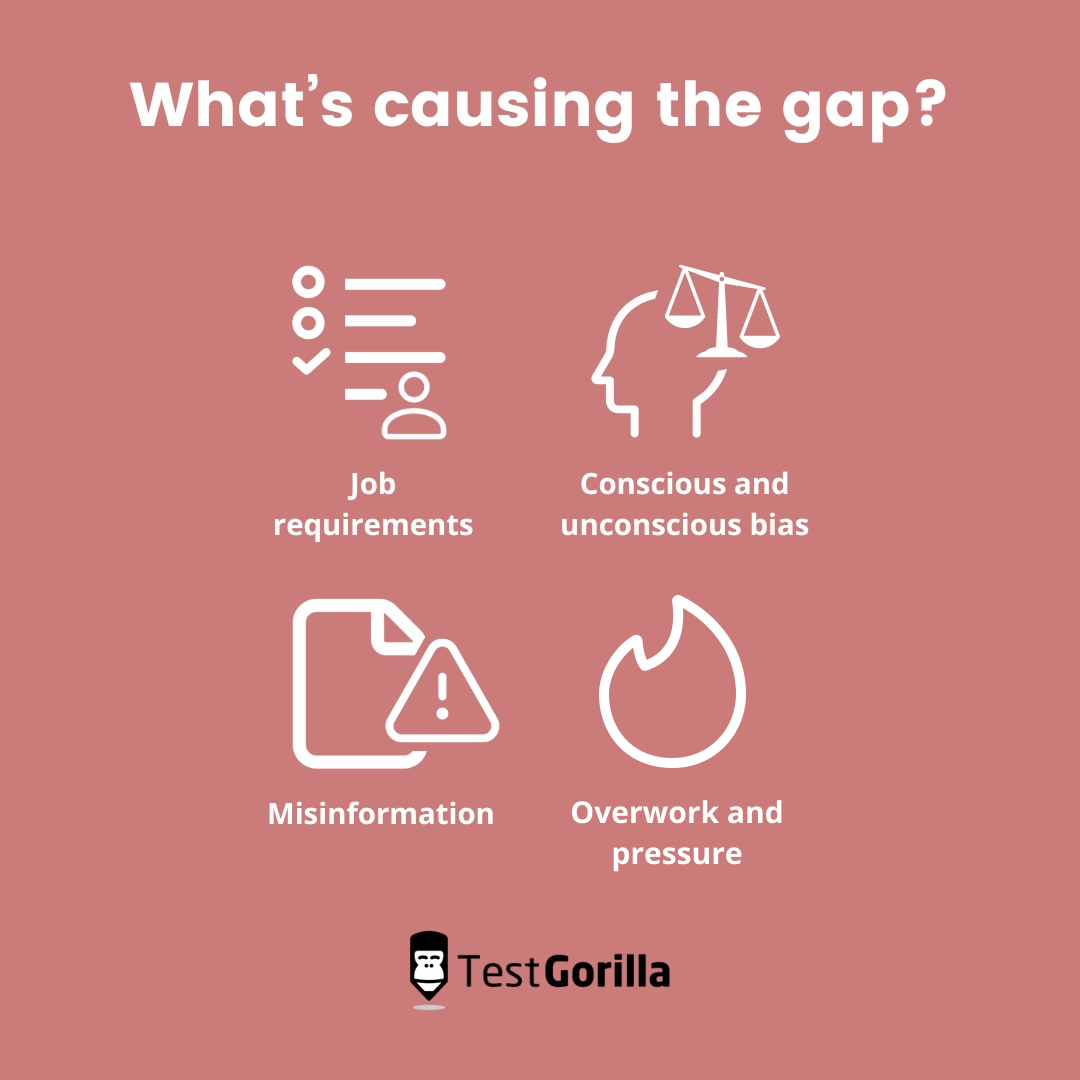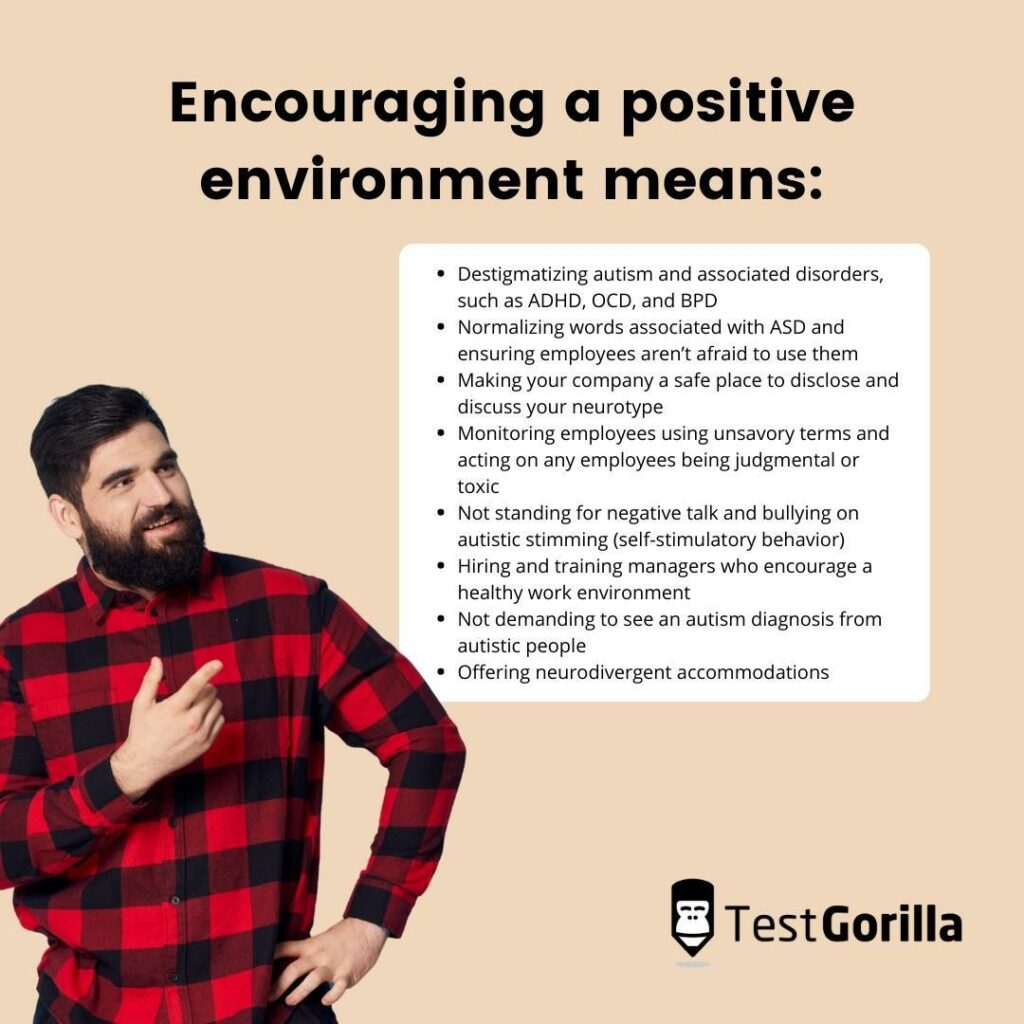The ASD (autism spectrum disorder) employment gap is shocking, with a recent UK study showing that only 29% of autistic adults are employed.[1]
This means that autistic people face the second lowest employment rate among all people, disabled or otherwise.
It’s been proven time after time that traditional ideas about autism are misinformed, ignorant, and incorrect. True autism is a spectrum, and the people on it are hard-working, intelligent, and creative.
Yet employers continue to have unfair biases and hold on to archaic beliefs that harm millions of the workforce.
It’s estimated that one in forty-four people is autistic.[2] Not having these people working leaves a huge source of candidates untapped, narrowing the talent pool and excluding real people from living their lives.
The problem is an overreliance on recruitment practices that were never designed for neurodivergent individuals – emphasis on work experience and resumes, and little focus on demonstrable skill.
Let’s dive into the issue and the solution we hope more companies adopt.
About the ASD employment gap
There’s an uncomfortable imbalance between the number of autistic people in the workforce versus the amount that want jobs.
Despite facing such an alarmingly low employment rate, a study by Too Much Information (TMI) found that 77% of those autistic people want to work.[3]
This gap is far beyond a negligible difference and isn’t just a case of the better person being hired. Autistic people have capabilities and skills just the same as their neurotypical peers, and in many cases, may have capabilities that others don’t.
Some companies, like GCHQ and BAE Systems, are specifically searching for neurodivergent and women candidates, keen to close both the autism employment gap and the gender employment gap.
Code First Girls, a social enterprise that works with GCHQ and BAE Systems, said that they were searching for women with ASD because of their fast pattern recognition, sharp accuracy, and great attention to detail.
These natural skills that autistic people possess align with most of the jobs they shoot for, too. TMI’s above study also found that the top fields autistic people are interested in are the arts, IT, admin and office work, and scientific research and development.
Incorporating more autistic people into your company’s culture also increases workplace diversity, and a diverse range of perspectives boosts company-wide creativity, productivity, and problem-solving.
So if thousands of people want jobs, and their unique skills would benefit the company, what’s causing this surprising gap?
This huge statistical difference shows there’s a real problem in how our society perceives people with ASD and the unconscious and conscious bias that perception causes. Some of that problem can also be chalked up to traditional hiring processes.
When there’s an overreliance on a system made by and for neurotypical workers, it can’t help but exclude autistic people.
Let’s talk about this in depth.
What’s causing the gap?
A gap as large as this cannot be attributed to any single cause.
There are an unfortunate number of elements contributing to the issue, including that the majority of disabled people don’t have a college degree, and the unconscious and conscious bias against them.
Autistic people also have high rates of trauma, which makes a long employment history and a full resume less likely.
More factors that worsen this gap are traditional corporate life and hustle culture.
Standard corporate life is very harmful to autistic adults. For example, Lyric Holmans,[4] an influencer, consultant, and author of “Workplace Neurodiversity Rising,” discovered their autism through the struggles they faced in a typical corporate setting.
They faced burnout and depression from the blaring fluorescent lighting agitating their sensory sensitivities and the constant demands of hustle culture. This eventually culminated in a total mental breakdown before they were finally diagnosed with autism.[5]
“Until that point, I had been trapped in an endless cycle of burning myself out because I didn’t understand that my pace could and should be different from the pace of people around me. I didn’t understand my differences or how to speak up for them.”
Lyric Holmans
This employment gap isn’t a question of whether or not autistic people can do the job. It’s the issue that few people know what autism really is and how it affects a person.
Very few people want to invest the time needed to learn, too. With so much misinformation and archaic perceptions floating around, most people believe there’s nothing to learn.
The ASD employment gap is caused by these four factors: job requirements, conscious and unconscious bias, misinformation, and overwork.
Let’s look more closely at them.
Job requirements
Common job requirements include years of work history and an extensive educational background, such as four-year degrees.
The same study that found that only 29% of autistic adults are employed additionally found that the majority of disabled people don’t have the same educational qualifications as their peers**[1]**.
The study showed that half as many disabled people have a degree as their highest qualification in comparison to their non-disabled peers, and are three times as likely to have no qualifications at all.
Autistic people are also ten times more likely to have trauma than neurotypical people, and those who have suffered trauma are much less likely to have a consistent employment history and a high degree of education.
A 2020 study showed that people with trauma are 73% less likely to finish a university degree. This isn’t a question of intelligence. People suffering trauma are facing extra problems that simply make finishing a degree that much harder.
Unnecessarily restrictive job requirements can also affect people of color, younger candidates, and older candidates, making this practice a DE&I and ageist issue, as well.
And in the end, these certifications do nothing to display whether or not the candidate can get the job done.
Conscious and unconscious bias
One of the largest factors in the ASD employment gap is bias, both unconscious and conscious.
Both of these types of biases are harmful and prevent hardworking autistic people from getting solid jobs to support themselves.
Conscious bias: People who rely on outdated information and misinformation believe harmful things about autistics being “in their own world” or “needing caregivers.”
Unconscious bias: People who rely on certain “professional behaviors” may judge candidates who have trouble with eye contact or handshakes, among many other physical behaviors like stimming.
Unconscious bias is one of the biggest problems because even employers who believe they’d never judge someone differently may end up doing so by accident.
It gets worse when you consider that many neurotypical people unconsciously view autistic people as “unlikeable,” mainly due to awkwardness and a perceived lack of empathy.
We say “perceived” because not every autistic person struggles with empathy, but even those that do shouldn’t be inherently written off as “toxic” or “unsociable.”
Devon Price, an autistic social psychologist, speaks in-depth that it isn’t strictly empathy that creates a good person, but rather their actions and behavior in any given situation.
A separate study published by the National Library of Medicine found that neurotypical peers are much less willing to interact with autistic people,[6] and the judgments they make occur within seconds and do not change with time.
These biases affect early-stage hiring but extend to the roles autistic people receive upon being hired.
“I was shoehorned into applying for work that was way below what my qualifications indicated. And I felt I was treated as one of a mass rather than my needs being taken into account.”
Quote from The National Autistic Society’s report “The autism employment gap” (2016)
Misinformation
Much of the information available about autistic people was written by neurotypical people. This presents a huge issue, as even very well-meaning people can’t articulate the differences, needs, and problems of people they aren’t.
This is similar to other controversies, such as men writing about women’s struggles, or white people talking about the struggles of people of color.
The overwhelming amount of information written by neurotypicals has led to the social media hashtag “#actuallyautistic” to denote when information has actually been written by autistic people.
Misinformation is harmful and makes people believe they know everything there is to know about a topic, which spreads the conscious and unconscious bias from our last point.
This also damages the confidence that autistic people have in finding work, which, according to TMI, is the top reason they don’t even try to find a job.[3]
Overwork and pressure
Typical corporate landscapes aren’t built for most autistic people. Hustle culture, pressure, and expectations can make securing and retaining a job nearly impossible.
It can weigh heavily even on a neurotypical employee to put in 70-hour work weeks and attend every company meeting and party, but autistic people feel that pressure and burnout all the more intensely.
This means work demands, intense lighting, and team parties can be overwhelming and stressful. Nothing’s wrong with autistic people – they’re just surviving in a world not built for them.
Their brains are simply built differently. And these differences are a benefit to the workplace, not a hindrance. That’s why it’s imperative to offer accommodations.
Offering accommodations helps them work in an environment suited to them rather than their neurotypical peers – like giving a pool to a turtle in the desert. Nothing’s wrong with him, he just isn’t a tortoise.
The best insights on HR and recruitment, delivered to your inbox.
Biweekly updates. No spam. Unsubscribe any time.
What companies can do to close the gap
These problems require active solutions. Ignoring the issue won’t reduce bias or make a more accessible workplace.
So what can your company do to close the ASD employment gap and hire more autistic candidates?
Employers hold so much power to create meaningful change for the professional futures of millions of autistic people.
Ditch reliance on resumes
Increasingly, more recruiters are doubting the efficacy of resumes and cover letters.
They filter out excellent candidates with unconventional backgrounds and force many candidates to self-select out of the race because they believe their resumes aren’t “strong enough.”
As we mentioned above, resumes won’t display an autistic person’s real talent. They aren’t as likely to have four-year degrees or the “right” work experience.
TestGorilla’s own Sheena Muirden, our content marketing coordinator, is a neurodivergent person with a mixed professional background.
She says her work history of being a waitress and working at an airline would normally have prevented her from securing a marketing role, which is where she really shines. But, as TestGorilla doesn’t rely on resumes, we were able to spot her talent.
According to our own global survey, recruiters agree that resumes are problematic. Only 56% of executives believe resumes are effective, and 44% of recruiters agreed that they only rely on them because they have no other way to rank candidates.
What’s another way to rank the capability if you don’t use resumes?
Let’s talk about skills-based hiring.
Opt for skills-based hiring
Skills-based hiring focuses on assessing relevant, measurable skills to find the ideal candidate based on talent. This enables recruiters to see a prospect’s capability in action without relying on resumes.
Typically, this means that the candidate’s skills are assessed before the resume (although we recommend discarding the practice entirely). Candidates are evaluated based on evidence first and foremost, instead of gut feelings and their background.
Skills-based hiring helps find stellar jobs for autistic people whose true talents aren’t tied to their work experience or education. Many of these people are even experts in their fields due to the talent in question being a devoted special interest.
For example, the writer of this blog has a special interest in writing, journalism, and content creation, although his work experience doesn’t reflect that.
Software like TestGorilla enables employers to evaluate candidates on real capability: technical skills, language proficiency, and soft skills.
Recruiters set criteria for recruitment and let the assessments speak for the candidate’s real skill – not a resume that could be outdated or inaccurate.
This gives employers a chance to eject more bias out of the hiring process. With that comes more diversity and the discovery of otherwise overlooked hidden talents.
Skills-based hiring takes down numerous barriers to employment, which means it not only helps autistic candidates, but also women, candidates of color, and older candidates.
Use structured interviews
Traditional unstructured interviews can be problematic for autistic people. They could even have stellar resumes, but once it comes to the interview, they can suffer.
Typical job interviews rely on and expect quick answers, eye contact, tone of voice, joking and palling around, and our standard idea of “charisma.”
Autistic people can struggle with most of these points, which gives the interviewer the impression that they’re inexperienced or not confident when that’s simply not the case.
Structured interviews are a more accessible, skills-based method to interview potential hires.
These interviews have predetermined questions and a set order to ask them. They also focus on the core competencies of the role and don’t wander off-topic to discuss common hobbies or schooling shared between the candidate and the interviewer.
In a structured interview, you know exactly what you’re looking for and when you’ve found it. This means that an autistic person with a monotone voice or a slower processing speed can still ace the interview as long as they provide sought-after answers.
Going off-script in a structured interview is also much more accessible for autistic people, as it’s still going to be relevant to the role, not joking about commonalities.
A structured interview only goes off-script to delve more deeply into the candidate’s answers.
Encourage a positive, inclusive work environment
Ensuring your workplace is safe and inclusive encourages more diverse candidates, whether they’re on the autism spectrum or otherwise.
Judgment and bias are some of the top pressures that autistic people face, and they’re much more common than any of us would like to admit.
A study done in Germany showed that adults with ASD have higher-than-average education, but the unemployment rates are still five times higher than neurotypical people.
These researchers concluded that their unemployment is linked to bias rather than a lack of qualifications.
Most autistic people say the main thing they want out of a workplace is to be understood and accepted.
With so many of them afraid to even disclose their neurotype for fear of judgment, harassment, and losing their jobs, it’s safe to say that exclusivity is a significant factor in this employment gap.
Encouraging a positive environment means:
Destigmatizing autism and associated disorders, such as ADHD, OCD, and BPD
Normalizing words associated with ASD and ensuring employees aren’t afraid to use them
Making your company a safe place to disclose and discuss your neurotype
Monitoring employees using unsavory terms and acting on any employees being judgmental or toxic
Not standing for negative talk and bullying on autistic stimming (self-stimulatory behavior)
Hiring and training managers who encourage a healthy work environment
Not demanding to see an autism diagnosis from autistic people
Offering neurodivergent accommodations (more on that below)
Taking steps like this not only makes autistic people breathe a little easier but also helps make your company safer and more accepting of many other diverse employees.
Educate your workforce on ASD
Misinformation can be damaging to an autistic person’s job prospects and professional future, and it spreads like wildfire.
Corporate spaces are sadly very misinformed and rely heavily on Autism Speaks, which is questionable at best and controversial at worst.
You can combat this by educating your people on what autism really is, what it entails, and which terms are acceptable for use.
Here are a few terms you can kick to the curb right now:
Aspergers – An old, archaic term coined by a controversial doctor from World War II Germany (a term that is still in use to help people transition away from using it)
High-functioning – Implies there’s a certain way people should “function” and also excuses employers and peers from accommodating “high-functioning” autistics
Differently-abled – Many autistic people feel both demeaned by this term and simultaneously believe that it’s ignoring their very real disabilities
Person with autism – Many autistic people aren’t fond of “people first” language
This last point is called “people first language” and comes from a seemingly innocent place. Others say they don’t want to “define someone” by their autism, but autistic people argue that every moment is defined by their autism.
ASD people also argue that autism isn’t a negative thing, so why not be defined by it? Such as transgender people and Catholic people – they aren’t “people with Catholicism” or “people who are transgender.”
They’re defined by these things because they’re positive terms, and the people are proud of them.
Let’s briefly discuss the controversial “high-functioning” label and what you should be using instead.
Autistic people should be described by their own experiences, such as “non-verbal” or “fluently verbal.” You can also use terms directly relating to their needed level of support.[7]
The best bet is to call an autistic person simply “autistic” unless they tell you a label they’re comfortable with.
Offer accommodations
Accommodations can make or break an autistic person’s experience in their professional life.
Due to sensory needs, bright fluorescent lights or loud conversation can cause stress, burnout, and depression, as well as decrease focus and performance.
Companies should offer accommodations to neurodivergent employees openly and proudly without making people feel like they’re “perks.”
These accommodations aren’t made to elevate neurodivergent folks higher; they simply help people perform at the same level.
Here’s a handful of possible accommodations you can offer:
Flexible work arrangements, like remote and hybrid offices
Visual instructions
Dimmer lighting
More moderate temperatures
Flexible work hours
Fragrance-free environments
A private office
Thorough change management practices to help cope and prepare for differences
A success story about accommodations comes from Kyle Hill, a science educator and entertainer, who was diagnosed with autism in 2016.[8]
Kyle was working at Nerdist, a pop culture and entertainment company, in an open-space office with ten other people. This open space meant constant distractions and small talk, and after his diagnosis, he realized that he needed an office to better concentrate and focus.
It was a little bit of a struggle to get this accommodation, but once he did, his output and productivity doubled.
Another accommodation Kyle speaks about is the courtesy shown towards his misophonia (a strong reaction to certain sounds). To help him cope with it, his colleagues ask if he needs his door closed when they’re about to make a loud sound, such as opening a bag of chips.
Make sure to offer accommodations in your hiring process, as well.
For example, our tests ask candidates upfront if they need any special accommodations, and automatically account for those accommodations during the assessment.
Clay Slang, our growth product manager, says this feature immediately made him feel welcome at TestGorilla, and comfortable enough to disclose his neurodivergence from the first interview.
Not only do such accommodations help to include all candidates, but they also signal your company’s commitment to fostering a positive environment for employees.
Accommodations enable autistic people to work at their peak performance and shouldn’t be seen as perks or bonuses. These disabilities and sensitivities require courtesy and care. You wouldn’t tell a person with a walking disability that an elevator was a “bonus,” for instance.
Close the gap with skills-based hiring and tap into autistic talent
When companies are over-reliant on a hiring process that was never built for autistic people, they can’t be expected to thrive, let alone survive. And this abysmal 29% employment rate will remain unless organizations take steps to adopt accessible, equitable practices.
Skills-based hiring is one of the best solutions to adopt, simply because it relies on capability, ditches the resume, and reduces bias.
Bias is damaging to countless individuals. Millions of capable autistic people are jobless simply because of who they are – how they were born.
With your company’s help, we can turn “You aren’t making eye contact.” or “You’re fidgeting too much.” into:
“I see your true skill and potential.”
These solutions won’t solve the problem overnight, but it’s a meaningful move to help build a better, safer work environment and professional space for autistic people.
Note that this article was written by an autistic person. #actuallyautistic
Sources
“Outcomes for disabled people in the UK: 2021”. (February 10, 2022). Office For National Statistics. Retrieved January 3, 2023.
“Autism Prevalence Higher in CDC’s ADDM Network”. (December 2, 2021). CDC. Retrieved January 3, 2023. https://www.cdc.gov/media/releases/2021/p1202-autism.html
“The autism employment gap.” (August 31, 2016). The National Autistic Society. Retrieved January 3, 2023. https://www.basw.co.uk/system/files/resources/basw_53224-4_0.pdf
Holmans, Lyric. “Neurodivergent Rebel – Rebelling against a culture that values assimilation over individuality”. Retrieved January 3, 2023. https://neurodivergentrebel.com/
Holmans, Lyric. (March 30, 2022) “#AskingAutistics – Did it Become Harder to Camouflage As You Got Older?”. SpectrumLife. Retrieved January 3, 2023.
Sasson, Noah; Faso, Daniel; Nugent, Jack; Lovell, Sarah; Kennedy, Daniel; Grossman, Ruth. (February 2017). “Neurotypical Peers are Less Willing to Interact with Those with Autism based on Thin Slice Judgments.” Scientific Reports. Retrieved January 3, 2023.
Rudy, Lisa Jo. (July 13, 2022). “Understanding the Three Levels of Autism”. Verywell Health. Retrieved January 3, 2023. https://www.verywellhealth.com/what-are-the-three-levels-of-autism-260233
Hill, Kyle. “No question is too nerdy.” Kyle Hill. Retrieved January 3, 2023.
You've scrolled this far
Why not try TestGorilla for free, and see what happens when you put skills first.


